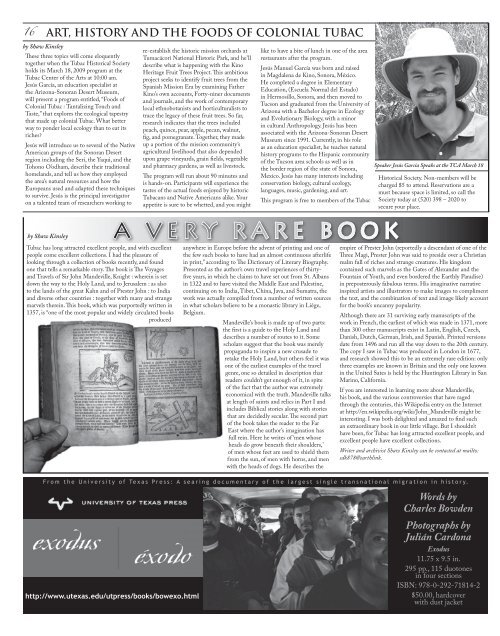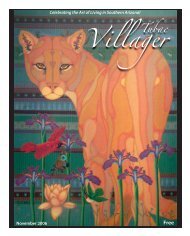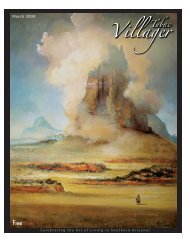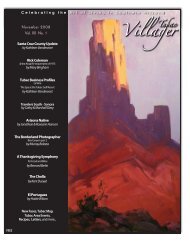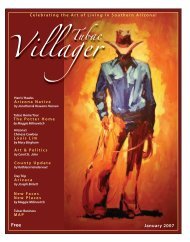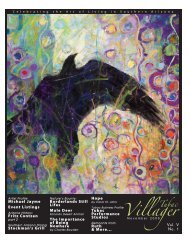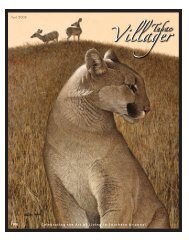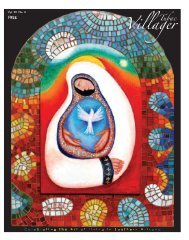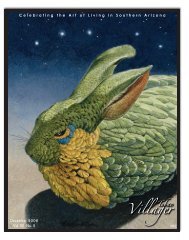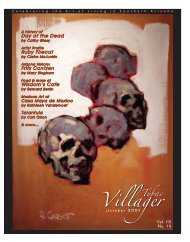You also want an ePaper? Increase the reach of your titles
YUMPU automatically turns print PDFs into web optimized ePapers that Google loves.
ART, HISTORY AND THE FOODS OF COLONIAL TUBAC<br />
by Shaw Kinsley<br />
Th ese three topics will come eloquently<br />
together when the <strong>Tubac</strong> Historical Society<br />
holds its March 18, 20<strong>09</strong> program at the<br />
<strong>Tubac</strong> Center of the Arts at 10:00 am.<br />
Jesús García, an education specialist at<br />
the Arizona-Sonoran Desert Museum,<br />
will present a program entitled, “Foods of<br />
Colonial <strong>Tubac</strong> : Tantalizing Touch and<br />
Taste,” that explores the ecological tapestry<br />
that made up colonial <strong>Tubac</strong>. What better<br />
way to ponder local ecology than to eat its<br />
riches?<br />
Jesús will introduce us to several of the Native<br />
American groups of the Sonoran Desert<br />
region including the Seri, the Yaqui, and the<br />
Tohono O’odham, describe their traditional<br />
homelands, and tell us how they employed<br />
the area’s natural resources and how the<br />
Europeans used and adapted these techniques<br />
to survive. Jesús is the principal investigator<br />
on a talented team of researchers working to<br />
by Shaw Kinsley<br />
<strong>Tubac</strong> has long attracted excellent people, and with excellent<br />
people come excellent collections. I had the pleasure of<br />
looking through a collection of books recently, and found<br />
one that tells a remarkable story. Th e book is Th e Voyages<br />
and Travels of Sir John Mandeville, Knight : wherein is set<br />
down the way to the Holy Land, and to Jerusalem : as also<br />
to the lands of the great Kahn and of Prester John : to India<br />
and diverse other countries : together with many and strange<br />
marvels therein. Th is book, which was purportedly written in<br />
1357, is “one of the most popular and widely circulated books<br />
produced<br />
re-establish the historic mission orchards at<br />
Tumacácori National Historic Park, and he’ll<br />
describe what is happening with the Kino<br />
Heritage Fruit Trees Project. Th is ambitious<br />
project seeks to identify fruit trees from the<br />
Spanish Mission Era by examining Father<br />
Kino’s own accounts, Forty-niner documents<br />
and journals, and the work of contemporary<br />
local ethnobotanists and horticulturalists to<br />
trace the legacy of these fruit trees. So far,<br />
research indicates that the trees included<br />
peach, quince, pear, apple, pecan, walnut,<br />
fi g, and pomegranate. Together, they made<br />
up a portion of the mission community’s<br />
agricultural livelihood that also depended<br />
upon grape vineyards, grain fi elds, vegetable<br />
and pharmacy gardens, as well as livestock.<br />
Th e program will run about 90 minutes and<br />
is hands-on. Participants will experience the<br />
tastes of the actual foods enjoyed by historic<br />
<strong>Tubac</strong>ans and Native Americans alike. Your<br />
appetite is sure to be whetted, and you might<br />
like to have a bite of lunch in one of the area<br />
restaurants after the program.<br />
Jesús Manuel García was born and raised<br />
in Magdalena de Kino, Sonora, México.<br />
He completed a degree in Elementary<br />
Education, (Escuela Normal del Estado)<br />
in Hermosillo, Sonora, and then moved to<br />
Tucson and graduated from the University of<br />
Arizona with a Bachelor degree in Ecology<br />
and Evolutionary Biology, with a minor<br />
in cultural Anthropology. Jesús has been<br />
associated with the Arizona-Sonoran Desert<br />
Museum since 1991. Currently, in his role<br />
as an education specialist, he teaches natural<br />
history programs to the Hispanic community<br />
of the Tucson area schools as well as in<br />
the border region of the state of Sonora,<br />
Mexico. Jesús has many interests including<br />
conservation biology, cultural ecology,<br />
languages, music, gardening, and art.<br />
Th is program is free to members of the <strong>Tubac</strong><br />
anywhere in Europe before the advent of printing and one of<br />
the few such books to have had an almost continuous afterlife<br />
in print,” according to Th e Dictionary of Literary Biography.<br />
Presented as the author’s own travel experiences of thirtyfi<br />
ve years, in which he claims to have set out from St. Albans<br />
in 1322 and to have visited the Middle East and Palestine,<br />
continuing on to India, Tibet, China, Java, and Sumatra, the<br />
work was actually compiled from a number of written sources<br />
in what scholars believe to be a monastic library in Liège,<br />
Belgium.<br />
Mandeville’s book is made up of two parts:<br />
the fi rst is a guide to the Holy Land and<br />
describes a number of routes to it. Some<br />
scholars suggest that the book was merely<br />
propaganda to inspire a new crusade to<br />
retake the Holy Land, but others feel it was<br />
one of the earliest examples of the travel<br />
genre, one so detailed in description that<br />
readers couldn’t get enough of it, in spite<br />
of the fact that the author was extremely<br />
economical with the truth. Mandeville talks<br />
at length of saints and relics in Part I and<br />
includes Biblical stories along with stories<br />
that are decidedly secular. Th e second part<br />
of the book takes the reader to the Far<br />
East where the author’s imagination has<br />
full rein. Here he writes of ‘men whose<br />
heads do grow beneath their shoulders,’<br />
of men whose feet are used to shield them<br />
from the sun, of men with horns, and men<br />
with the heads of dogs. He describes the<br />
Speaker Jesús García Speaks at the TCA March 18<br />
Historical Society. Non-members will be<br />
charged $5 to attend. Reservations are a<br />
must because space is limited, so call the<br />
Society today at (520) 398 – 2020 to<br />
secure your place.<br />
empire of Prester John (reportedly a descendant of one of the<br />
Th ree Magi, Prester John was said to preside over a Christian<br />
realm full of riches and strange creatures. His kingdom<br />
contained such marvels as the Gates of Alexander and the<br />
Fountain of Youth, and even bordered the Earthly Paradise)<br />
in preposterously fabulous terms. His imaginative narrative<br />
inspired artists and illustrators to make images to compliment<br />
the text, and the combination of text and image likely account<br />
for the book’s uncanny popularity.<br />
Although there are 31 surviving early manuscripts of the<br />
work in French, the earliest of which was made in 1371, more<br />
than 300 other manuscripts exist in Latin, English, Czech,<br />
Danish, Dutch, German, Irish, and Spanish. Printed versions<br />
date from 1496 and run all the way down to the 20th century.<br />
Th e copy I saw in <strong>Tubac</strong> was produced in London in 1677,<br />
and research showed this to be an extremely rare edition: only<br />
three examples are known in Britain and the only one known<br />
in the United Sates is held by the Huntington Library in San<br />
Marino, California.<br />
If you are interested in learning more about Mandeville,<br />
his book, and the various controversies that have raged<br />
through the centuries, this Wikipedia entry on the Internet<br />
at http://en.wikipedia.org/wiki/John_Mandeville might be<br />
interesting. I was both delighted and amazed to fi nd such<br />
an extraordinary book in our little village. But I shouldn’t<br />
have been, for <strong>Tubac</strong> has long attracted excellent people, and<br />
excellent people have excellent collections.<br />
Writer and archivist Shaw Kinsley can be contacted at mailto:<br />
sdk878@earthlink.<br />
From the University of Texas Press: A searing documentary of the largest single transnational migration in history.<br />
Words by<br />
Charles Bowden<br />
Photographs by<br />
Julián Cardona<br />
Exodus<br />
11.75 x 9.5 in.<br />
295 pp., 115 duotones<br />
in four sections<br />
ISBN: 978-0-292-71814-2<br />
$50.00, hardcover<br />
with dust jacket


